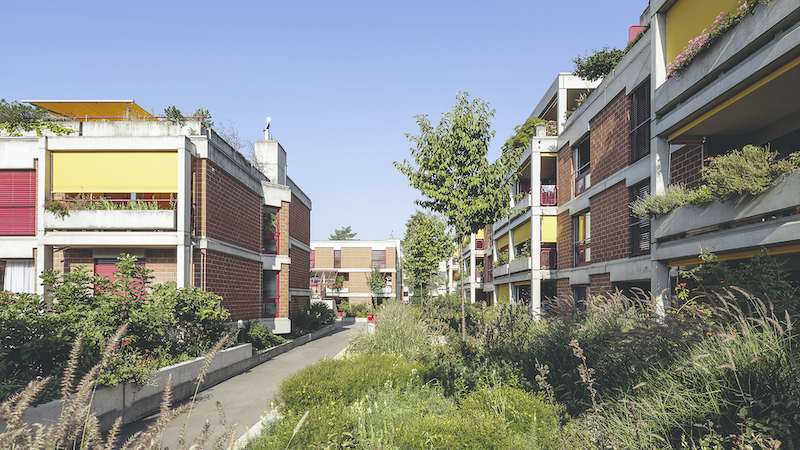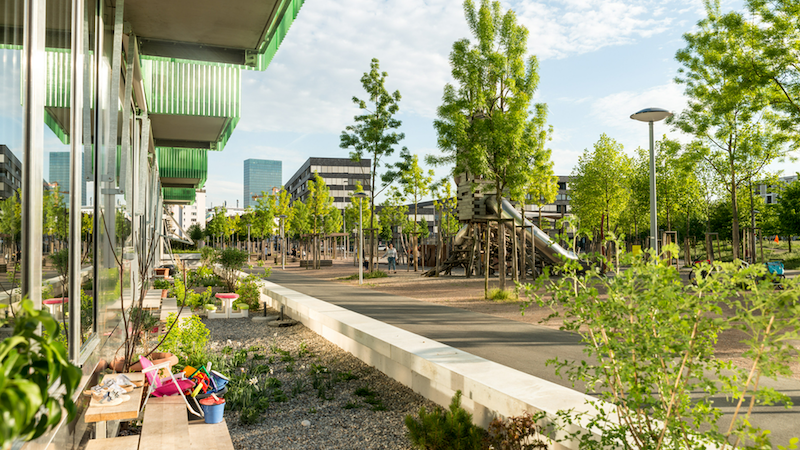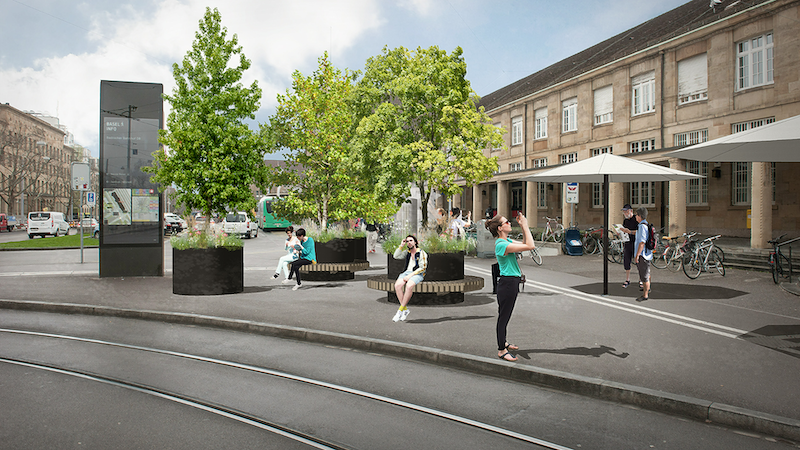Greening, shading and watering
Scritto da Swissbau
Basel, Svizzera
02.01.24
Cities and housing developers react sensitively to heatwaves and are making more and more room for cooling measures in their planning. Here are a few insights from Basel and Zurich.
Basel-Stadt is serious about improving the urban climate. For the redevelopment of the VoltaNord site, a set of rules stipulates how heat islands in the urban environment are to be prevented. A broad spectrum of measures stipulates, for example, that large areas of outdoor space should be unsealed and more trees planted, that more greenery is also required on the roofs and facades of new buildings, and that the latter should be aligned from the outset so that cooling winds can continue to flow through the newly built neighbourhood without obstruction. And what can no longer be neglected in contrast to previous planning projects: space is needed underground so that trees can take root and meteoric water can seep away on site.
Residents want a garden room
Different location, different approach, but the same goal: anticipatory heat reduction thanks to more greenery. When renovating its housing estates, the Zurich housing cooperative Eigengrund also focuses on its outdoor spaces and transforms them into "garden rooms". Over ten years ago, the cooperative asked its residents for the first time what would attract them to their own front door. With the help of landscape architects and experts from universities of applied sciences, this initially led to the garden idea and then to internal standards on how to enhance the space around the residential buildings in a natural way and improve the local climate. The knowledge gained from this also helped to certify the cooperative housing estates with the Swiss Sustainable Building Standard (SNBS).
Whether voluntarily, as in Zurich, or by building regulations in Basel: as important as energy-efficient buildings are for curbing climate change, building owners in urban environments are increasingly turning to protecting the neighbourhood population from summer heatwaves.
Urban environment is sensitive
The summer of 2003 caused heat records to tumble and health warnings to be issued for the first time. Since then, alarm values have become almost commonplace. In 2023, MeteoSwiss recorded by far the warmest year since measurements began 160 years ago and a heatwave that lasted almost the entire summer quarter. The Swiss Tropical and Public Health Institute explains the comparatively low number of deaths with a relatively low number of tropical nights. This is because when night-time temperatures fall below 20 °C, older people can recover well physically from hot days.
The risk of overheating is particularly high in urban neighbourhoods. As the cantonal climate analysis maps for Zurich and Basel show by way of example, sealed and sparsely greened squares become veritable heat islands. Asphalt floors and building façades heat up during the day to such an extent that dense residential neighbourhoods are at least 4 to 6 °C warmer at night than in a cooled settlement with a view of a meadow and forest edge. Accordingly, many Swiss cities are now in the process of planning climate adaptation. Three years ago, Zurich presented an overview of heat mitigation in urban planning. Basel-Stadt published an urban climate concept and an action plan in summer 2021.
Many dozens of new trees
For the time being, Basel is focussing on pragmatic, fast-acting measures. Renovation projects for streets and squares that are already underway are being reviewed for climate improvement options. In the detailed plan, it is often still possible to replace sealed surfaces with gravel and greenery. In contrast, Triangle Square, which was created a few years ago, was given a subsequent facelift with the addition of almost 20 trees. And soon, 80 trees and shrubs will line and cool the popular Rhine riverside path between the Dreirosenbrücke bridge and the French border.
"We need to green, shade and irrigate," continues Basel Councillor Esther Keller. Large areas in the city must also be cooled. The executive envisages specific heat reduction measures for around "80 hot and highly frequented places". Where trees cannot be planted, mobile elements are to provide shade. Greenery can also be organised with movable pots and planter boxes. Further plans include greening façades and unsealing areas according to the sponge city principle. The Basel government is applying to the cantonal parliament for expenditure of CHF 9.4 million for this purpose. In addition, the authorities want to create more incentives for private property owners to remodel their properties to reduce heat.
Cityscape will change
According to Councillor Keller, Basel's cityscape should change for the better, "although this won't happen overnight". Orders for heat protection are decided quickly, but nature is not the only thing that needs time to grow and blossom. That is why the transformation in the VoltaNord area is also taking a far-sighted approach: The regulations for local climate adaptation were formulated three years ago; in the meantime, the first construction machines are starting to move in. They are helping to realise an urban quarter for 1500 to 2000 people as well as areas for commercial and leisure use. This now also includes several large green spaces - and the trees will find their rightful place on the alleyways and streets leading to them from the outset.
The following events on the topic of urban climate will take place at Swissbau 2024:
Climate-friendly construction: 3 areas of tension in focus
Greening buildings makes a difference
Choice of materials in times of climate crisis
© Architonic
Head to the Architonic Magazine for more insights on the latest products, trends and practices in architecture and design.








